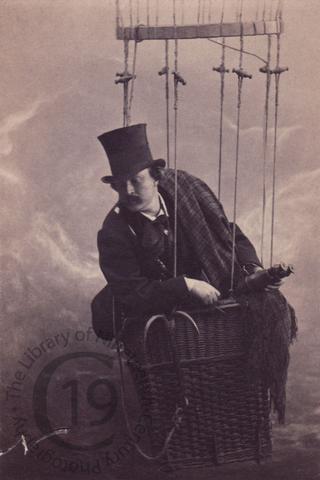
Nadar
Real name Félix Tournachon, Nadar was born in Paris in 1820. A theatre critic, writer, and publisher of literary magazines he also found fame as a successful caricaturist, but when in 1854 he took up photography, his talent and originality (plus an astonishing aptitude for self-promotion) ensured that he quickly became the most famous photographer of his day. He was the first to work with artificial light taking photographs in the Paris catacombs, and when he became a keen balloonist, he naturally took his cameras with him, taking the first aerial photographs of his native city. The vast studio that he opened in1860 at 35 Boulevard des Capucines drew customers of name and rank, and members of the bohemian circle. At night, his famous sign, his own scarlet signature across the façade of the building, was illuminated by gas flames. However, the great Paris studios were, for the most part, founded with external capital, and the photographer ostensibly at the helm was often no more than the salaried employee of demanding share-holders. A foreigner in his own realm, Nadar was soon cursing ‘this idiot’s profession, so insipid after thirteen years of work.’
The following is a description of Nadar by Ernest Lacan, taken from the British Journal of Photography (15 October 1862):
‘At once a humourist in literature, a spirited caricaturist, and a clever photographer, he bears in his whole person the stamp of originality. His size is herculean, his hair and moustache of a light yellow hue, is dressed in a red flannel blouse, and altogether looks like a satanic apparition. Red, too, is his colour of predilection. His wall-hangings, woodwork, inscriptions, signature, and even the fillet-border round his pictures, are all in red. His glass-house is a veritable garden, with rock and cascade and numerous perennials. His saloon is furnished with oriental luxury, and crowded with costly objects and works of art. What gives special interest to this apartment are the numerous frames which cover its walls, and contain all Nadar’s original caricatures with three pencils. All the contemporary celebrities are there, each with his characteristic feature in strong relief. There they are also in more sober photographic guise, so that you can judge on the spot of the artist’s double talent.’
Self-portrait by the photographer.
Code: 124230




